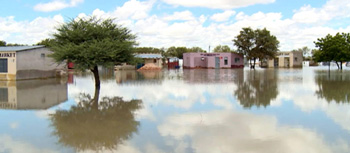
Weather 07 October 2016
What Happened
A low pressure system with a well-defined vortex just south of Madagascar presented itself at the beginning of the week as the main synoptic feature. Alas that was not to be as it fizzled out over two days becoming a subdued area of lower pressure in the western wing of the southern Indian high pressure cell.
As always, the main contender proved to be the South Atlantic high and this week was no exception. While most of the sub-continent registered low pressure conditions due to solar irradiation, the south-western corner started to feel the impact of the approaching South Atlantic high by Wednesday night. A surprisingly cool Thursday morning was the result felt on the surface. The cooling covered about two thirds of Namibia with only the Okavango, Babwatwa and Zambezi remaining under the influence of the heat-low, thus still very hot.
By Thursday the low pressure vortex south of Madagascar has collapsed, merging into the broad lower pressure band ahead of the approaching South Atlantic high. Although the vortex was of brief duration, two days at most, it did contribute to relieve the high pressure control over eastern Africa, a major obstacle for moisture to migrate from the Indian Ocean to central Africa.
High pressure systems are by nature descending whether they are on the surface or in the higher levels of the atmosphere. Even though surface temperatures under the control of a high pressure cell may often become very hot due to diabatic compression, the overall vertical motion is negative, i.e. descending towards the earth. This prevents convection, thus preventing cloud formation. It is only when the upper air high pressure control is fractured by a strong vortex (low pressure) that positive conditions develop for convection. This is what typically happens over eastern Africa in the transition from winter to summer, when the atmosphere increases in depth, the 500 mB dam line moves vertically to a higher level, and the locomotive that drives the southern African summer rain, gains in strength.
This week’s vortex and its upper level impact over the southern half of eastern Africa, is a precursor to similar but stronger repeats of the same phenomenon. However, the moisture conveyor will only function optimally once the high pressure ridge over eastern Africa is gone and the upper airflow resumes a strong east to west zonal flow. That is not yet the case.
What’s Coming
The core of the next South Atlantic high approaches the west coast over the weekend bringing another round of cool night temperatures to the southern Namib and the Karas region. Saturday night will be markedly cooler in the Keetmanshoop and Karasburg districts but the temperatures should not go below 10°C.
The system moves rapidly to the east, and in a weird twist of events, the leading forecasts expect the South Atlantic high to collapse during Sunday, very similar to what happened to the vortex this week. By Monday, the remnant of the former South Atlantic high sits over South Africa, extending its signature ridge over Botswana and the eastern half of Namibia. Its impact will be minimal, though and by Monday night, lower pressure conditions originating from central Africa will cover two thirds of Namibia, bringing windy conditions, especially at night, and very hot afternoons.
By Wednesday next week, the next South Atlantic high approaches, causing a marked pressure differential between the interior and the coastal plain which should lead to windy conditions over the southern Namib. Ahead of this system a convergence zone runs from southern Angola, across the north-eastern quadrant of Namibia and into Botswana. East of the convergence line, convection will be enhanced and there is a good possibility of light rain over the central north, the Kavango, Bushmanland, Hereroland East and the northern half of the Gobabis district. This system will move to the east, taking the rainfall prospects to Babwatwa and the Zambezi.










































